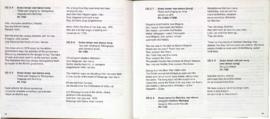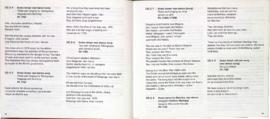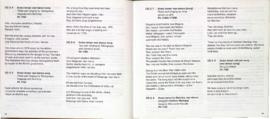Title and statement of responsibility area
Title proper
Series 10: The Collection of Father Franz Mayr, Zulu Recordings,1908, (Disc 2) and associated materials from the accompanying Data CD
General material designation
- Sound recording
- Textual record
- Graphic material
Parallel title
Other title information
Title statements of responsibility
Title notes
- Source of title proper: FHYA using ÖAW materials
Level of description
Subseries
Repository
Reference code
Edition area
Edition statement
Edition statement of responsibility
Class of material specific details area
Statement of scale (cartographic)
Statement of projection (cartographic)
Statement of coordinates (cartographic)
Statement of scale (architectural)
Issuing jurisdiction and denomination (philatelic)
Dates of creation area
Date(s)
Physical description area
Physical description
• 24 Sound Recordings
• 27 Lyrics Transcripts and Translations
• 3 Music Notations
Publisher's series area
Title proper of publisher's series
Parallel titles of publisher's series
Other title information of publisher's series
Statement of responsibility relating to publisher's series
Numbering within publisher's series
Note on publisher's series
Archival description area
Custodial history
[Source - Gerda Lechleitner for FHYA , 2016, using ÖAW materials: Franz Mayr was a Catholic missionary living and working in Natal between 1890 and 1909. Father Willem Schmidt, the editor of the anthropological journal ‘Anthropos’, and a member of the Austrian Academy of Sciences, suggested that Mayr and three other Catholic missionaries receive phonographs to preserve indigenous music from various parts of the world. According to Schmidt’s protocols Mayr made his recordings in September 1908. However Mayr’s own earlier publications suggest that these recordings were actually made before this date. Mayr used an Edison phonograph and wax cylinders to record songs in the Natal region of South Africa. This material was given to the Phonogrammarchiv at the then Imperial Academy of Sciences in Vienna (now known as the Austrian Academy of Sciences or the Österreichische Akademie der Wissenschaften). The Phonogrammarchiv copied the wax cylinders onto wax discs. They used the wax discs to make metal negatives. The wax discs were destroyed in a bombing during WWII, but the metal negatives remained. New casts, made from epoxy resin, were made by the Phonogrammarchiv, using these metal negatives. Following this, the recordings underwent a digitisation process. Franz Lechleitner, Nadja Wallaszkovits and Johannes Spitzbart transferred the original recordings to modern data storage media, edited them, and cleaned the signals from surface noises.
The transfer was done by means of electromagnetic stereo pick-ups. Every attempt was made to meet the standards of modern re-recording (use of high quality equipment, centring of the disc, careful choice of styli). The flat amplified signals of the stereo pick-up were stored as master transfers, serving as the source for further editing procedures. Generally, the speed indicated in the original protocols was chosen for the CDs. However, if the reference speed of the protocol was evidently incorrect, the speed was corrected to a more plausible value. Such corrections were always explicitly indicated. In order to prepare listeners for the historical sound quality, start grooves were faded in and end grooves were faded out. In the case of recordings featuring a sudden beginning or end, context noise was used for fading. As a matter of principle, no further signal processing was undertaken. However, in cases of extremely poor recordings, the Phonogrammarchiv took the liberty of adding an extra version where de-noising or another editing procedures allowed for partial improvements to the sound quality. Contents presumably extending across more than one phonogram were published as one single track, edited to represent one continuous recording, with each beginning of a phonogram being marked in the transliteration/ transcription, and in doubtful cases a short fading separated the individual recordings. They then produced master CDs. Gerda Lechleitner was the executive editor of this project. In 2006, Phonogrammarchiv published a complete version of the audio CD, along with an extensive CD booklet and Data CD.]
Scope and content
[Source - Debra Pryor for FHYA, 2019: Subseries comprise files which contain digital reproductions of audio originally recorded on wax cylinders, extracted from CD2 of the "Series 10: The Collection of Father Franz Mayr Zulu Recordings 1908", lyrics, transcripts and translations from the CD booklet, and handwritten protocols extracted from data CD.]
Notes area
Physical condition
Immediate source of acquisition
Arrangement
Language of material
Script of material
Location of originals
Availability of other formats
Restrictions on access
Terms governing use, reproduction, and publication
Creative Commons License: CC BY-NC-ND
https://creativecommons.org/licenses/by-nc-nd/3.0/
Unless otherwise stated the copyright of all material on the FHYA resides with the contributing institution/custodian.
Finding aids
Associated materials
Accruals
Alternative identifier(s)
Standard number area
Standard number
Access points
Subject access points
Place access points
Name access points
- Five Hundred Year Archive (FHYA) (Online curation)
- Austrian Academy of Sciences (ÖAW) (Publication)
- Reverend Father Franz Mayr (Collection)


![Ndabambi Kunene and his wife - Ihubo lamabuto: war song [literally: song of the warriors] Two-par...](/uploads/r/austrian-academy-of-sciences-oaw/c/a/8/ca86904436c2baa122b2b381569908c4d4cc30b13a299d12550d5c5f867be362/OAW_Mayr_1908_The_Collection_of_Father_Franz_Mayr_Zulu_Recordings_handwritten_protocol_Ph_1758_142.jpg)
![Ndabambi Kunene and his wife - Ihubo lamabuto: war song [literally: song of the warriors] Two-par...](/uploads/r/austrian-academy-of-sciences-oaw/7/6/6/76653c953c234721e63cf01ed743108a9d6d7d20307b2038afac0b05cc689ceb/OAW_Mayr_1908_The_Collection_of_Father_Franz_Mayr_Zulu_Recordings_lyrics_transcript_and_translation_Ph_1758_pp50-51_142.jpg)
![Ndabambi Kunene and his wife - Ihubo lamabuto: war song [literally: song of the warriors] Two-par...](/uploads/r/austrian-academy-of-sciences-oaw/f/5/7/f5734e17bdb42df4850cf55c51fa7be1ed60dc43b6bcfcd0423797ee3e87980e/OAW_Mayr_1908_The_Collection_of_Father_Franz_Mayr_Zulu_Recordings_music_notation_Ph_1758_142.jpg)
![Ihubo lamabuto: war song [literally: song of the warriors] Sung by Pakati, handwritten protocol](/uploads/r/austrian-academy-of-sciences-oaw/5/6/3/5634b245511733bdc7127e4956a2137d1d85e409baeadb865e3622bca530d31f/OAW_Mayr_1908_The_Collection_of_Father_Franz_Mayr_Zulu_Recordings_handwritten_protocol_Ph_1760A-1760B_142.jpg)
![Ihubo lamabuto: war song [literally: song of the warriors] Sung by Pakati, lyrics transcript and ...](/uploads/r/austrian-academy-of-sciences-oaw/7/6/6/76653c953c234721e63cf01ed743108a9d6d7d20307b2038afac0b05cc689ceb/OAW_Mayr_1908_The_Collection_of_Father_Franz_Mayr_Zulu_Recordings_lyrics_transcript_and_translation_Ph_1760A-1760B_p51_142.jpg)
![Ihubo lempi: war [dance] song Two-part singing by Maria Theresa Kanyile and Maria Gertrude Mkize,...](/uploads/r/austrian-academy-of-sciences-oaw/3/4/c/34c2d5839567b1f12e1b1aa0baaf19dacac381f9c2b3a1c75106d59eb685bbf8/OAW_Mayr_1908_The_Collection_of_Father_Franz_Mayr_Zulu_Recordings_handwritten_protocol_Ph_1759_142.jpg)
![Ihubo lempi: war [dance] song Two-part singing by Maria Theresa Kanyile and Maria Gertrude Mkize,...](/uploads/r/austrian-academy-of-sciences-oaw/7/6/6/76653c953c234721e63cf01ed743108a9d6d7d20307b2038afac0b05cc689ceb/OAW_Mayr_1908_The_Collection_of_Father_Franz_Mayr_Zulu_Recordings_lyrics_transcript_and_translation_Ph_1759_p51_142.jpg)






Material contributed by members of the public
Building an archive is a collective endeavour. Please help us grow the FHYA knowledge base.
If you want to add information to this page you can insert a hyperlink, add files and/or text to the box below.
In the case of material relevant to the FHYA as a whole please upload information HERE.
The FHYA does not vet this material but reserves the right to remove anything deemed to be racist, homophobic, sexist or otherwise offensive. Everything on the FHYA is licensed under a Creative Commons CC BY-NC-ND licence.
To make a contribution you must be a registered user. To register an account, click here. Note that after registration you will not be automatically redirected to this page.
If you have already registered but are not logged in, log in here.